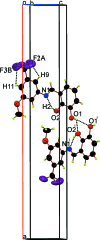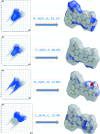(Z)-3-({[3-Meth-oxy-5-(tri-fluoro-meth-yl)phen-yl]imino}meth-yl)benzene-1,2-diol
- PMID: 31161059
- PMCID: PMC6509687
- DOI: 10.1107/S2056989019003220
(Z)-3-({[3-Meth-oxy-5-(tri-fluoro-meth-yl)phen-yl]imino}meth-yl)benzene-1,2-diol
Abstract
The title compound, C15H12F3NO3, crystallizes with one mol-ecule in the asymmetric unit. The mean planes of the two phenyl rings of the Schiff base moiety, bearing the OH groups and the imine group, respectively, are inclined to each other by 4.91 (1)°. In the crystal, mol-ecules are linked via pairs of bifurcated O-H⋯O hydrogen bonds between the phenol OH groups, forming inversion dimers with an R 1 2(5) ring motif. The structure exhibits also intra-molecular O-H⋯N and C-H⋯F hydrogen-bonding inter-actions. Hirshfeld surfaces analysis and two-dimensional fingerprint plots were applied to qu-antify the inter-molecular inter-actions. The three F atoms of the tri-fluoro-methyl group are disordered over two sets of sites, with occupancy factors of 0.578 (8) and 0.422 (8). The crystal studied was refined as an inversion twin.
Keywords: Hirshfeld surface analysis; O⋯O interaction; Schiff base; crystal structure.
Figures


 .]
.]


References
-
- Akkaya, A., Erşahin, F., Ağar, E., Şenel, İ. & Büyükgüngör, O. (2007). Acta Cryst. E63, o3555. - PubMed
-
- Demir, S., Dinçer, M., Çukurovalı, A. & Yılmaz, I. (2006). Acta Cryst. E62, o298–o299.
-
- Demir Kanmazalp, S., Macit, M. & Dege, N. (2019). J. Mol. Struct. 1179, 181–191.
-
- Farrugia, L. J. (2012). J. Appl. Cryst. 45, 849–854.
-
- Grigoras, M., Catanescu, O. & Simonescu, C. I. (2001). Rev. Roum. Chim. 46, 927–939.
LinkOut - more resources
Full Text Sources
Research Materials
Miscellaneous
